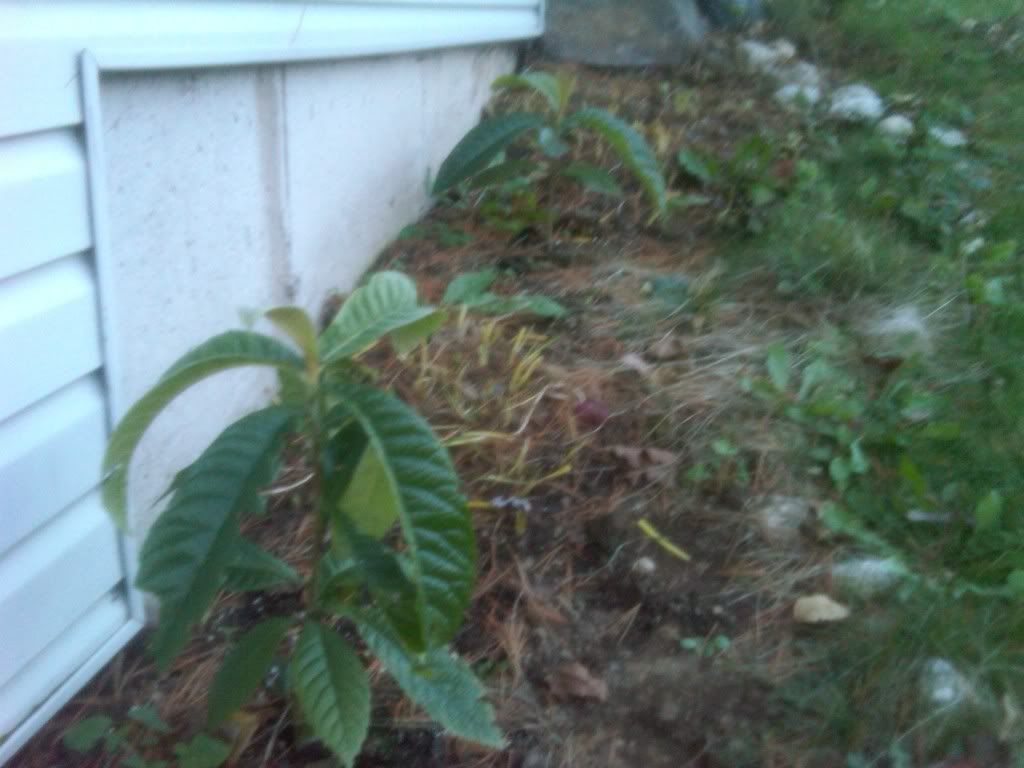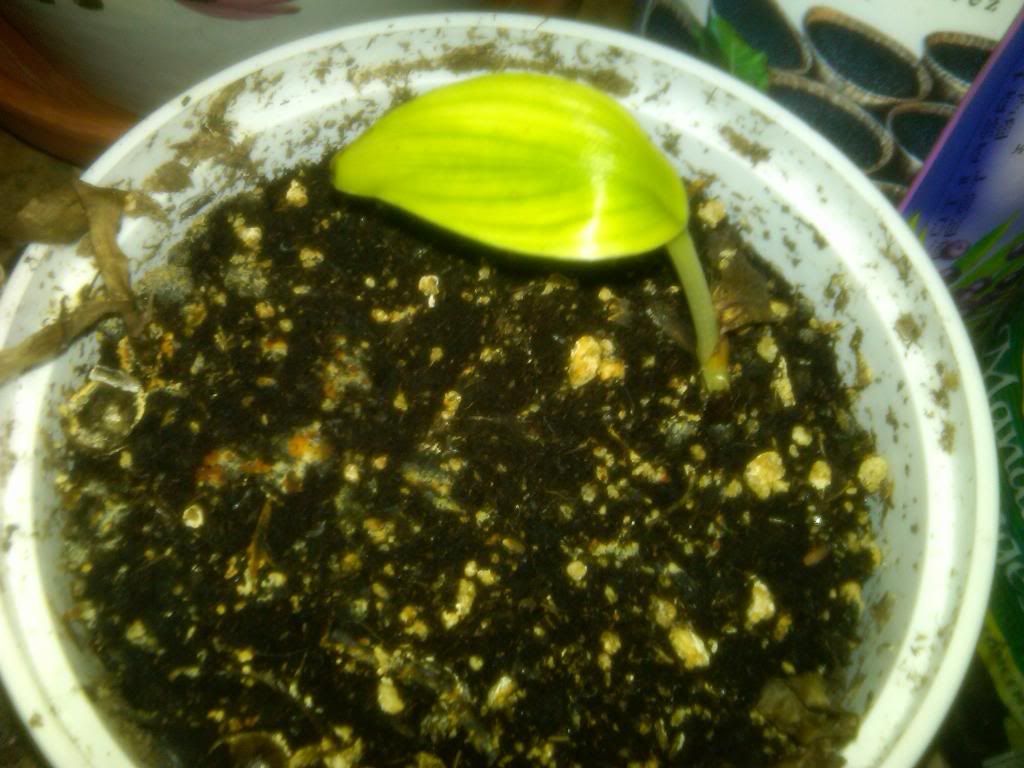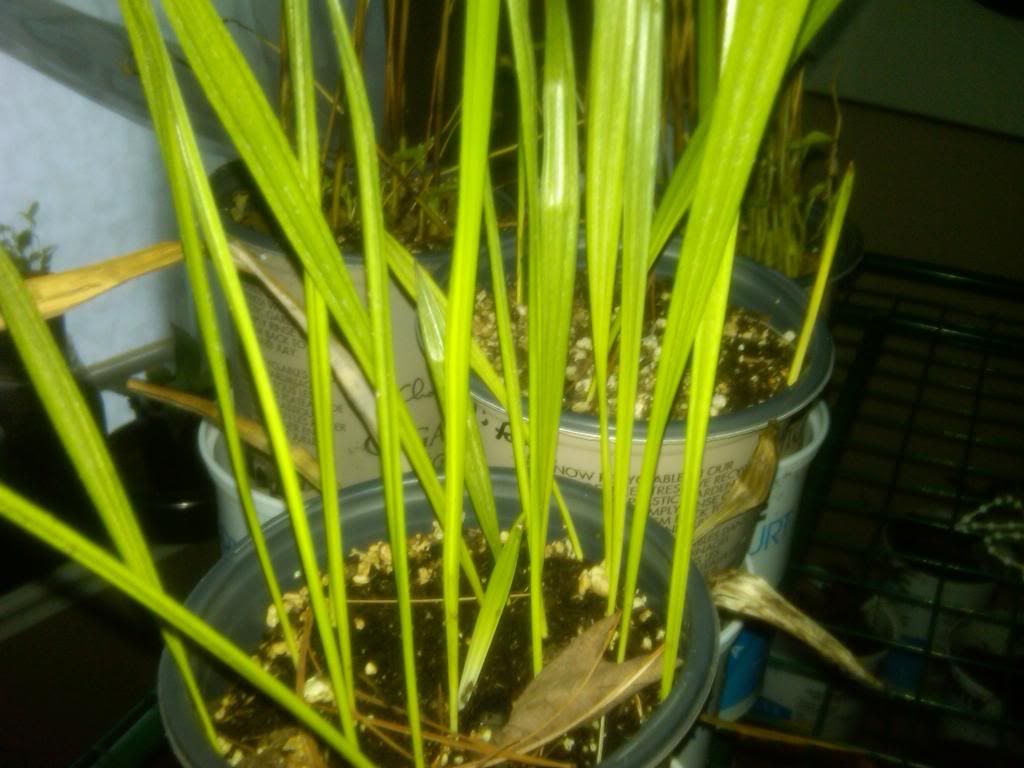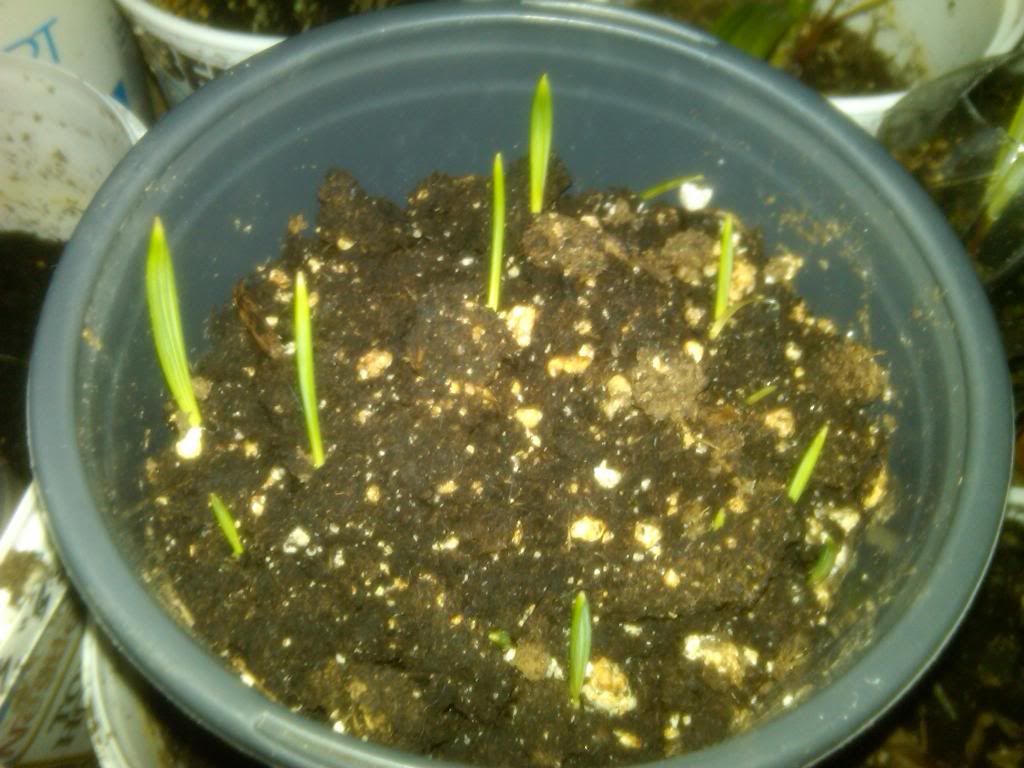Sheesh, Tim, seed updates usually show seedlings no taller than a thimble.
You've got some magic for growing stuff.
Well done. 😀
Barb
<img src="http://weathersticker.wunderground.com/weathersticker/cgi-bin/banner/ban/wxBanner?bannertype=wu_bluestripes_both&airportcode=CWJV&ForcedCity=Vernon&ForcedState=Canada&wmo=71115&language=EN" alt="Find more about Weather in Vernon, CA" width="160" />
If you drink, don't drive. Don't even putt.
Are the larger ones A. ecklonis?
Yes.......those are in year 2 now. They really took off this season......they were somewhat tiny going into last winter.
Did the Protea survive?
The Protea died after I transplanted them.......like 2 weeks later. I did not even disturb the roots/soil from the old container. The soil I placed them in must have been totally different? Not sure what happended. I was upset since they survived the winter in my garage with no issues.
I have 4 or 5 loquats planted in the ground, and will keep you updated on how they do over the winter.
Keep us updated on their progress. I'll probably plant one of my loquats outside in spring.
<a href="http://www.wunderground.com/US/MA/Seekonk.html?bannertypeclick=bigwx"><img src="http://weathersticker.wunderground.com/weathersticker/bigwx_both_cond/language/www/US/MA/Seekonk.gif" alt="Click for Seekonk, Massachusetts Forecast" border="0" height="60" width="468" />
Tim, in a couple of years you should really consider trying those A. ecklonis outdoors with excellent moisture protection. I have heard that they are hardy close to a zone 7a. Protea can be really tough to start from seed. Hopefully I'll be getting some more seeds soon, and will send you a few.
Loquats. The closer one is a little over 1', and the further one is close to 1' tall:
The Halifax area has had highs of 16 C and 18 C over the past two days, so the loquats are still putting out new leaves! The low so far this season has been -6 C, and that fried a lot of my outdoor plants.
<img src="http://weathersticker.wunderground.com/weathersticker/big2_both_cond/language/www/global/stations/71601.gif" alt="Click for Shearwater, Nova Scotia Forecast" border="0" height="60" width="468" />
Hi Cameron,
those hardy kiwis look great. Your Loquats are about the same size as mine.
Perhaps I'll plant out one of the Aloes next spring and see what happens. I was at Steve's garden in New Jersey (hardy palm board) a few weeks ago and he had a couple Aloe aristatas outside. Nice to see.
<a href="http://www.wunderground.com/US/MA/Seekonk.html?bannertypeclick=bigwx"><img src="http://weathersticker.wunderground.com/weathersticker/bigwx_both_cond/language/www/US/MA/Seekonk.gif" alt="Click for Seekonk, Massachusetts Forecast" border="0" height="60" width="468" />
Tim, that's good to hear. You're right, the loquats are about the same size.
<img src="http://weathersticker.wunderground.com/weathersticker/big2_both_cond/language/www/global/stations/71601.gif" alt="Click for Shearwater, Nova Scotia Forecast" border="0" height="60" width="468" />
Hi Cameron,
here's an update showing the damage on the Aloe plants from a brief drop to 23F. I think they too much moisture in our climate and loose a lot of their hardiness.
<a href="http://www.wunderground.com/US/MA/Seekonk.html?bannertypeclick=bigwx"><img src="http://weathersticker.wunderground.com/weathersticker/bigwx_both_cond/language/www/US/MA/Seekonk.gif" alt="Click for Seekonk, Massachusetts Forecast" border="0" height="60" width="468" />
Tim, I think you're right about the moisture.
I've recently germinated some Sabal species (brazoria, domingensis, palmetto, etc) with no bottom heat. They were placed outdoors during the summer, but were brought inside before germination. I'll post some pics soon!
<img src="http://weathersticker.wunderground.com/weathersticker/big2_both_cond/language/www/global/stations/71601.gif" alt="Click for Shearwater, Nova Scotia Forecast" border="0" height="60" width="468" />
Some sources say not to let Aloes go below 45F so,
I would say your doing alright there 🙂
<img src="http://weathersticker.wunderground.com/weathersticker/big2_cond/language/www/US/IA/Fairfield.gif" alt="Click for Fairfield, Iowa Forecast" border="0" height="60" width="468" />
recently germinated some Sabal species (brazoria, domingensis, palmetto, etc) with no bottom heat.
Yes pics please.
Cameron, I'm curious how long it took for your Nannorhops ritchiana to pop last year.
Unfortunately the N. seedlings I got from you all croaked.
not to let Aloes go below 45F
My "dune" aloe is in the cold building and looks great.
It looks worse in summer in full sun and hot winds, often bone dry too.
Barb
<img src="http://weathersticker.wunderground.com/weathersticker/cgi-bin/banner/ban/wxBanner?bannertype=wu_bluestripes_both&airportcode=CWJV&ForcedCity=Vernon&ForcedState=Canada&wmo=71115&language=EN" alt="Find more about Weather in Vernon, CA" width="160" />
If you drink, don't drive. Don't even putt.
Jim, normally I would agree! But one species, A. ecklonis, is from some of the highest mountains in the Drakensberg range. This species is supposed to be zone 7 hardy, but I think soil moisture plays a big role in this aloe's hardiness!
Barb, out of all of the seeds that I de-lidded, N. ritchiana was one of the fastest to germinate. I had the bottom heat somewhere around 30 - 35 C. Send me a PM!
<img src="http://weathersticker.wunderground.com/weathersticker/big2_both_cond/language/www/global/stations/71601.gif" alt="Click for Shearwater, Nova Scotia Forecast" border="0" height="60" width="468" />
These Aloes were outside much longer (like 3 more weeks) and experienced colder temps and are actually frozen solid when I dug them up........no damage at all.
I also messed with Aloe striatula when I lived in Rhode Island back in 1999-2003 and it was rather hardy too.....it would die back to the ground but would resprout in spring. It wasn't as attractive as the variegated Aloe I have now.
<a href="http://www.wunderground.com/US/MA/Seekonk.html?bannertypeclick=bigwx"><img src="http://weathersticker.wunderground.com/weathersticker/bigwx_both_cond/language/www/US/MA/Seekonk.gif" alt="Click for Seekonk, Massachusetts Forecast" border="0" height="60" width="468" />
Cameron......The Aloe reitzii did not receive any damage where the A. ecklonis received moderate damage.....the ecklonis was a year older too. Perhaps the A. reitzii will prove hardier than Aloe variegata when mature??
<a href="http://www.wunderground.com/US/MA/Seekonk.html?bannertypeclick=bigwx"><img src="http://weathersticker.wunderground.com/weathersticker/bigwx_both_cond/language/www/US/MA/Seekonk.gif" alt="Click for Seekonk, Massachusetts Forecast" border="0" height="60" width="468" />
Tim, I had some seedling A. reitzii outdoors to temps of -6 C. They were kept completely dry, and most were undamaged.
<img src="http://weathersticker.wunderground.com/weathersticker/big2_both_cond/language/www/global/stations/71601.gif" alt="Click for Shearwater, Nova Scotia Forecast" border="0" height="60" width="468" />
Musa sp. "Helen's Hybrid" from Canadianplant:
Phoenix canariensis, and P. dactylifera x sylvestris behind them:
Sabal x brazoriensis. This species is hardier than many people believe. Some people have compared its hardiness to that of S. "Birmingham"! :
<img src="http://weathersticker.wunderground.com/weathersticker/big2_both_cond/language/www/global/stations/71601.gif" alt="Click for Shearwater, Nova Scotia Forecast" border="0" height="60" width="468" />
nice plants Cameron........what's the story with those citrus's? Are they hardy?
<a href="http://www.wunderground.com/US/MA/Seekonk.html?bannertypeclick=bigwx"><img src="http://weathersticker.wunderground.com/weathersticker/bigwx_both_cond/language/www/US/MA/Seekonk.gif" alt="Click for Seekonk, Massachusetts Forecast" border="0" height="60" width="468" />